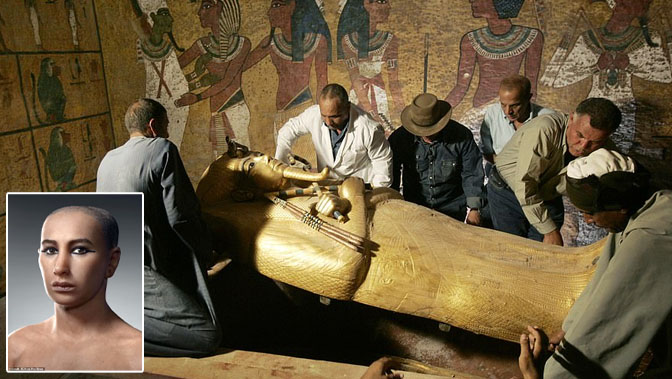King Tutankhamun´s Face is Seen for the First Time in Over 3,300 YEARS
Translator : Novita Cahyadi
Kamis, 01 Juni 2023

SELAMA ribuan tahun, wajah Raja Tutankhamun akhirnya terungkap setelah para ilmuwan membangun kembali wajahnya, mengungkapkan seorang firaun yang lebih mirip ´pelajar muda´ daripada seorang raja.
Ciri-cirinya dihidupkan kembali oleh tim akademisi internasional dari Brasil, Australia, dan Italia menggunakan model digital dari tengkorak muminya.
Rekonstruksi mengungkapkan wajah muda dan ´halus´ seorang raja yang masih remaja ketika dia meninggal lebih dari tiga ribu tahun yang lalu.
Pakar grafis Brasil Cicero Moraes, yang ikut menulis studi baru tersebut, mengatakan: ´Bagi saya dia terlihat seperti pria muda dengan wajah lembut.
´Melihatnya, kita lebih melihat seorang siswa muda daripada seorang politikus yang penuh tanggung jawab, yang membuat tokoh sejarah ini semakin menarik.´
´Bocah raja´ yang terkenal itu ditemukan bersama dengan lusinan harta karun yang luar biasa oleh arkeolog Inggris Howard Carter pada November 1922 di Lembah Para Raja Mesir.
Karena tim internasional tidak memiliki akses langsung ke tengkorak firaun, menyelesaikan model baru itu sangat menantang.
Untungnya, penelitian sebelumnya telah mencatat pengukuran tengkorak, dan menerbitkan gambar referensi.
Mr Moraes berkata: ´Itu adalah pekerjaan detektif, di mana jejak informasi digabungkan [dihubungkan bersama] untuk memberi kami model tengkorak tiga dimensi.
´Dengan data proporsi dan beberapa pengukuran sefalometri yang penting, tengkorak digital dari donor virtual dapat diambil dan disesuaikan sehingga menjadi tengkorak Tutankhamun.´
Dari sana, kata Moraes, mereka menciptakan kembali ´ukuran bibir, posisi bola mata, tinggi telinga, dan ukuran depan hidung´.
´Semua proyeksi ini didasarkan pada studi statistik yang dilakukan pada CT scan individu hidup dari beberapa keturunan yang berbeda,´ katanya.
Penanda kemudian diterapkan pada tengkorak yang menunjukkan ketebalan jaringan lunak di berbagai tempat, dengan menggunakan data dari orang Mesir modern sebagai panduan.
Dengan teknik ini dan lainnya, wajah secara bertahap dibangun kembali menjadi rekonstruksi yang objektif.
Elemen subyektif seperti warna mata kemudian ditambahkan untuk lebih memanusiakan subjek.
Ini bukan pertama kalinya para ilmuwan mencoba membangun kembali rupa firaun muda – upaya lain dilakukan pada tahun 2005, seperti dilansir MailOnline.
Michael Habicht, seorang Egyptologist dan arkeolog di Flinders University di Australia, yang ikut menulis studi baru tersebut, mencatat kemiripan yang mengejutkan antara kedua rekonstruksi tersebut.
Dia berkata: ´Rekonstruksi kami sangat dekat dengan yang dibuat oleh tim Prancis beberapa tahun yang lalu.
´Itu juga sesuai dengan penggambaran kuno Tutankhamun, terutama dengan kepala bunga teratai dari harta karun makamnya.´
TUTANKHAMUN stares at us through the millennia after scientists rebuilt his face, revealing a pharaoh that looks like more like a ´young student´ than a king.
His features were brought to life by an international team of academics from Brazil, Australia and Italy using a digital model of his mummified skull.
The reconstruction reveals the youthful and ´delicate´ visage of a king who was still a teenager when he died more than three thousand years ago.
Brazilian graphics expert Cicero Moraes, who co-authored the new study, said: ´To me he looks like a young man with a delicate face.
´Looking at him, we see more of a young student than a politician full of responsibilities, which makes the historical figure even more interesting.´
The famous ´boy king´ was discovered along with dozens of incredible treasures by British archaeologist Howard Carter in November 1922 in Egypt´s Valley of Kings.
Because the international team did not have direct access to the pharaoh´s skull, completing the new model was especially challenging.
Thankfully, previous studies had already recorded the skull measurements, and published reference images.
Mr Moraes said: ´It was a detective work, where traces of information were concatenated [linked together] in order to provide us with a three-dimensional model of the skull.
´With the proportion data and some important cephalometric measurements, it was possible to take the digital skull of a virtual donor and adjust it so that it became the skull of Tutankhamun.´
From there, Mr Moraes said, they recreated ´the size of the lips, the position of the eyeballs, the height of the ears and the front size of the nose´.
´All of these projections are based on statistical studies that were performed on CT scans of living individuals from several different ancestries,´ he said.
Markers were then applied to the skull indicating the thickness of soft tissues in various places, using data from modern Egyptians as a guide.
With these and other techniques, the face was gradually rebuilt into an objective reconstruction.
Subjective elements like eye colour were then added to further humanise the subject.
It´s not the first time scientists have tried to rebuild the likeness of the young pharaoh – another attempt was made in 2005.
Michael Habicht, an Egyptologist and archaeologist at Flinders University in Australia, who co-authored the new study, noted the startling resemblance between the two reconstructions, seperti dilansir MailOnline.
He said: ´Our reconstruction is amazingly close to the one made by a French team a few years ago.
´It also corresponds with the ancient depictions of Tutankhamun, especially with the head on the lotus flower from his tomb treasure.´
-
Mengenal Dark Factory
Pabrik Masa Depan- Mengenal Buzzer
Siap Tempur 24 Jam- Microsoft Luncurkan Majorana 1
Gerbang ke Dunia Matrix- DeepSeek
Bikin ChatGPT Ngumpet di Kolong Meja- iPhone 15 Segera Rilis, Bocoran Desain dan Fitur Beredar
Is THIS the iPhone 15? Leaked Images Reveal the Designs for All Four Models Rumoured - Mengenal Buzzer
